Ted Stevens Anchorage International Airport
**THE COMMENT PERIOD FOR THIS MEETING IS NOW CLOSED**
Welcome to the Virtual Meeting for the May 31, 2023 Anchorage International Airport Public Meeting.
The purpose of this virtual open house is to share the materials that were presented at the May 31, 2023, in-person open house. This online platform is open from May 31 to June 13, 2023. Your feedback is important to us! You may visit the last station of this meeting or visit the website at ancmpu.com.
Navigating this site:
This site is best viewed on your desktop or laptop computer at 100% view. You may click the tabs in the left navigation to visit each poster station. If you prefer to experience this Online Meeting in text format only, visit the Text Only page of this meeting.
Begin by choosing a station button below

Welcome
Welcome to the Anchorage Master Plan Virtual Open House.
The purpose of this virtual open house is to share the materials that were presented at the May 31, 2023, in-person open house. This online platform is open from May 31 to June 13, 2023.
Feedback
Your feedback is important to us! Visit the Comnments section of this meeting to leave your feedback.
Documents
You will also find documents presented at the in-person meeting linked below.
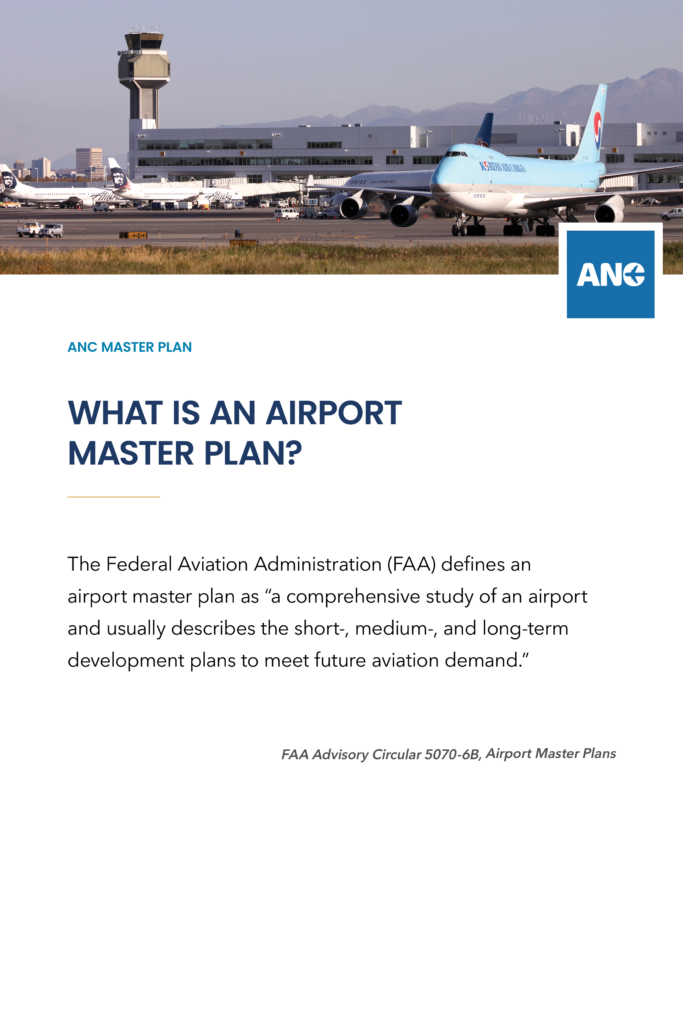
What is an Airport Master Plan?
The Federal Aviation Administration (FAA) recommends that all airports have up-to-date master plans. A master plan serves as a blueprint for an airport’s long-term development and is typically updated every 5 to 7 years. The Airport last completed a Master Plan Update from 2012 to 2014. Since then, many changes have occurred that merit a new Master Plan Update. Of note, the Alaska and world economies have changed due to the rise of e-commerce, which has impacted cargo traffic. In Alaska, a prolonged recession impacted the local and state economies. The COVID-19 pandemic drastically altered travel patterns for several years, but they appear to be recovering to near normal passenger levels. Tourism in Alaska continues to grow.

What is an Airport Master Plan?
Master Plan Process Overview
Study Design
We review previous studies to develop a well-defined project approach that follows FAA guidance.
Vision, Goals & Objectives
Goals and objectives for the Master Plan Update are defined.
Aviation Forecast
Using feedback from the major airline stakeholders, develop an Aviation Forecast of projections for passengers, cargo, and operations at ANC Airport. The forecast will include insight on future activity and will be presented to the public after the data is accepted by FAA.
Inventory
Update any changes that have occurred since the previous master plan update. Airport staff, tenants, and stakeholders help identify changes in the existing conditions.
Facility Requirements
Facility requirements are primarily determined by technical analysis of existing facility data relative to forecast demand. For this Master Plan Update, facility requirements will rely upon demand-level trigger points to establish a need for additional throughput capacity. A trigger point is the point at which throughput exceeds an established facility capacity, degrading facility performance or level of service and triggering a need for an improved or expanded facility. This stands in contrast to using a calendar to establish a timeline for facility improvements.
Alternatives Development & Evaluation
Prepare conceptual development plans for meeting the established facility requirements. Typically, several solutions or alternatives are conceived to meet future facility needs.
The alternatives are screened using evaluation criteria to identify those that best to meet the Airport’s needs. Multiple alternatives are then refined and combined to more fully address airport needs and evaluation criteria and move forward.
Final Master Plan Report
The Facilities Implementation Plan provides recommendations on how to implement the Master Plan Update and the preferred alternative. This often includes a development schedule, cost estimates, phasing plan, identification of interrelated projects, and other special considerations. To-scale airport drawings that make up the ALP will be updated, depicting proposed developments that make up the selected alternative.
Master Plan Update conditions, findings, and development plans will be documented in a draft and a final report. The report will include a summary of public involvement activities and outcomes. The report will also include a financial feasibility analysis for identified Airport improvements. The final report will be published and made available to the public.

What is an Airport Master Plan?
The Master Plan Update is anticipated to take roughly 24 months to complete, with a final completion date of December 2024. The schedule may change. The best way to stay up to date is to sign up for email updates.
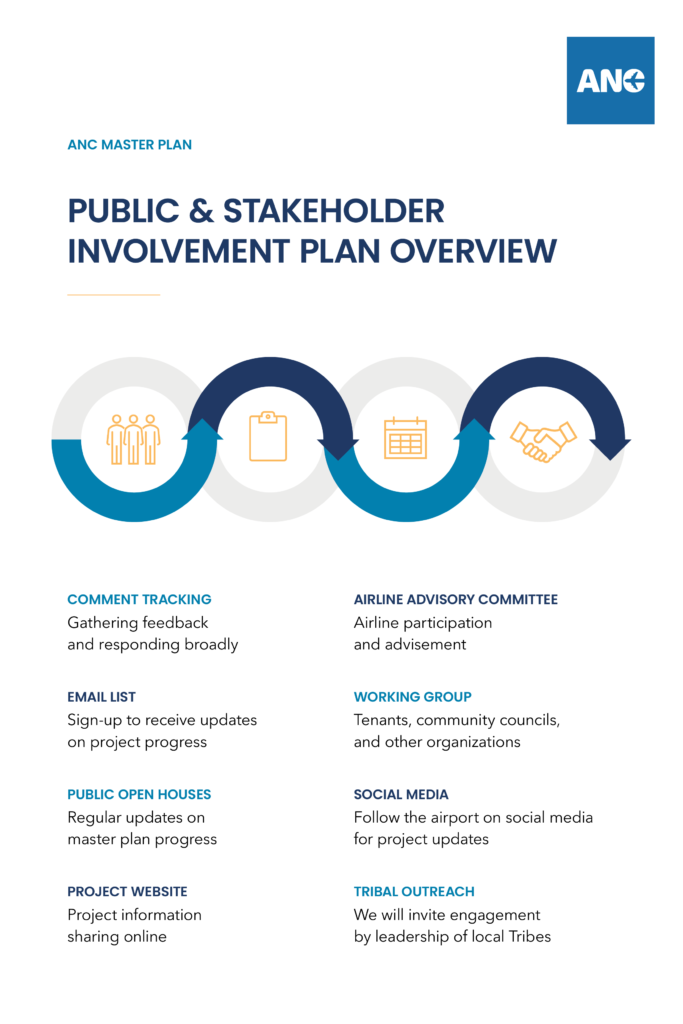
Public and Stakeholder Involvement Plan
The Public Involvement Plan identifies the steps in the Master Plan Update process and explains how public input can shape the plan. At each key decision point, the Master Plan Update project team and the Airport will solicit public input prior to the Airport making a decision.
Public Meetings will be held at each of these key points in the decision-making process:
-
- Goals & Objectives/Inventory
- Forecast
- Facility Requirements & Draft Alternatives
- Final Report
Advisory Committees
The Airport is convening two advisory committees comprised of airline professionals and community leaders. The purpose of the Airline Advisory Committee and the Working Group is to provide information and guidance on specific aspects of Master Plan Update development and to inform the decision-making process.
Online
Visit us at ancmpu.com to sign up for email updates, review materials, leave a comment, or reach the team.

Sustainability
Airports Council International-North America (ACI-NA) defines airport sustainability as “a holistic approach to managing an airport so as to ensure the integrity of the economic vitality, operational efficiency, natural resource conservation and social impact (EONS) of the airport.” ACI-NA includes operational efficiency as a key component of sustainability for airports.
-
-
- ‘E’ in EONS is addressed through the fiscal sustainability and operational efficiency goals.
- ‘O’ in EONS is addressed through the safety, efficiency, and land management goals.
- ‘N’ in EONS is addressed through the environmental sustainability, resilience, and efficiency goals.
- ‘S’ in EONS is addressed through the communication, and environmental sustainability goals.
-
Sustainability themes are incorporated into the Master Plan Update process and are foundational to the Master Plan Update purpose: to prepare a responsible development plan to meet future aviation demand.

Goals and Objectives
The goals and objectives will be used to evaluate alternative actions for meeting the primary purpose of the Master Plan Update: evaluating the best course of action for Airport development to meet future aviation demand.
The following draft goals were identified at the project’s outset in a staff and airport leadership workshop and are modestly evolved from the prior Master Plan. Project goals are broad statements about what the Airport hopes to achieve through the Master Plan Update process.

Goals and Objectives 1: Safety
Maintain or enhance the safe operation of the Airport
The Master Plan Update will prioritize and consider safety in every aspect of facility planning. The Airport operates safely today, and the Master Plan Update will seek to ensure that the Airport’s safe operation is maintained or enhanced with any recommended development.
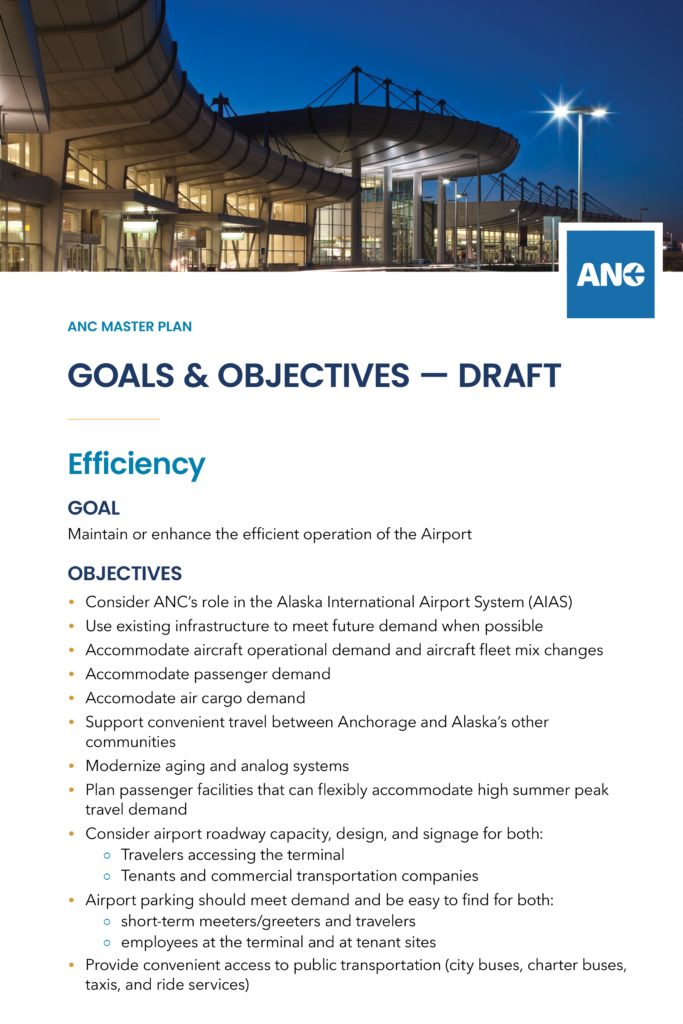
Goals and Objectives 2: Efficiency
Maintain or enhance the efficient operation of the Airport
The purpose of an airport master plan, as prescribed by FAA, is to plan future development to ensure that the airport can meet future aviation demand. Future demand may include growth in airplane operations or passengers and can also result in changes in airplane operations and passenger behavior. The master plan must consider how these changes will impact the airport and identify development that will enable the airport to continue operating with minimal delays or inconveniences for airport users.

Goals and Objectives 3: Environmental Awareness
Minimize the impact of airport development through environmental awareness
The Master Plan Update outlines the Airport’s role and responsibilities regarding addressing federal, state, and local environmental regulations. An environmental inventory, as well as high-level analysis of potential environmental impacts of the Airport’s current and future operation and facilities, are undertaken to address this goal.

Goals and Objectives 4: Fiscal Sustainability
Maintain the long-term fiscal sustainability of the Airport
Fiscal sustainability promotes planning of Airport improvements that allow the Airport to meet future demand affordably. The Master Plan Update includes assessment of the Airport’s financial capacity and will prioritize planned projects based on need and funding opportunity.

Goals and Objectives 5: Land Management
Facilitate long-term Airport development through strategic land management planning
Strategic land management is a process to evaluate the Airport’s existing land and assess the highest and best use for limited land resources. In some cases, the result identifies land assets for targeted development. In other cases, the result identifies land assets for preservation to enable the Airport’s future improvement.
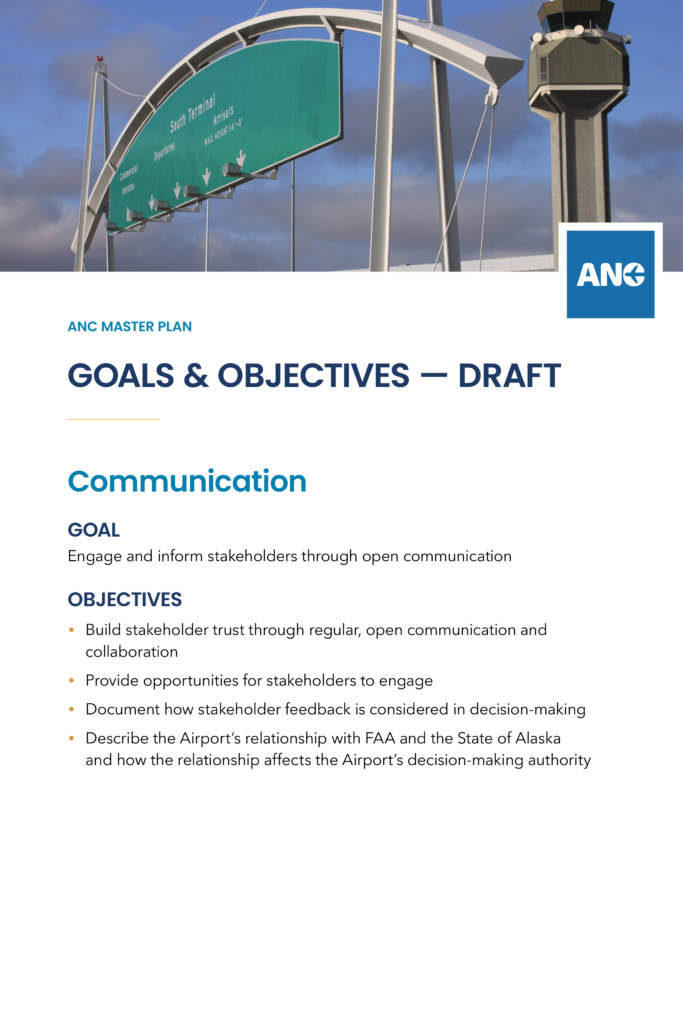
Goals and Objectives 6: Communication
Engage stakeholders through open communication
The Airport is a vital transportation and economic asset for the State of Alaska. Its continued operation is essential. The Master Plan Update must document and communicate the Airport’s importance and why its continued improvement is necessary. Likewise, the Master Plan Update is an opportunity for a wide range of stakeholders to participate in the planning process to communicate how they are impacted, both positively and negatively, by the Airport and its operation. This goal helps the Master Plan Update promote effective dialogue between the Airport and stakeholders.

Goals and Objectives 7: Resilience
Minimize impact of operational interruptions and disruptions
Airports can be impacted by both acute and chronic threats such as severe weather, volcanic eruptions, security breaches, sea level rise, and aging infrastructure. The Master Plan should consider how existing facilities can be enhanced to enable recovery that minimizes disruptions and allows the facility to reach appropriate capacities within desired timelines. The Plan should also consider how new facilities can be planned to address future changes and potential challenges to ensure its overall resilience in the long term.
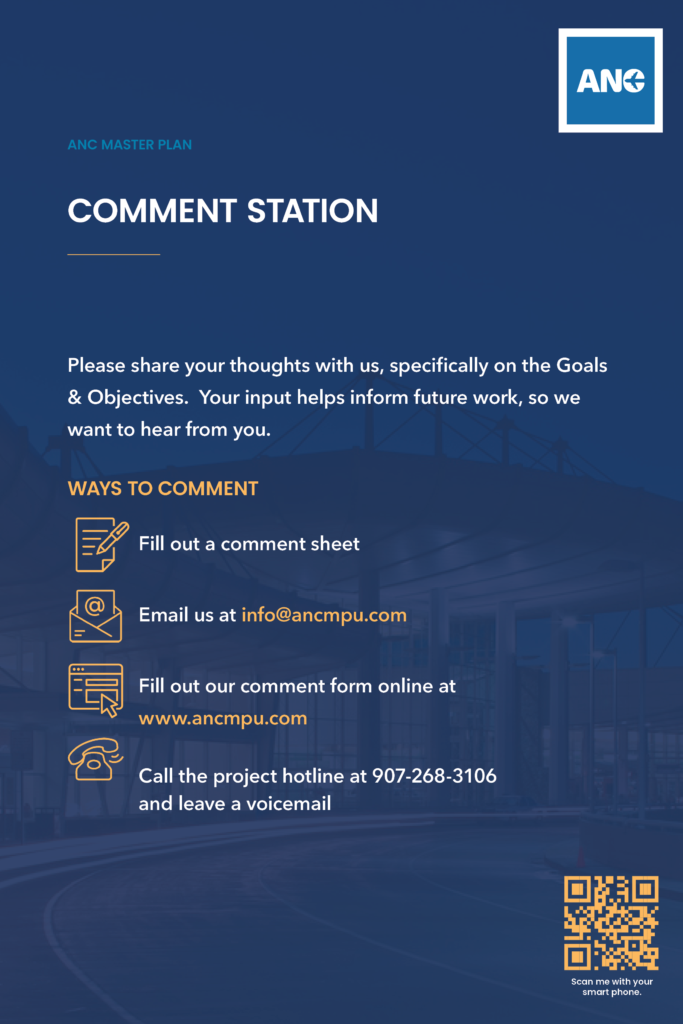
Goals and Objectives 7: Resilience
Please share your thoughts with us, specifically on the Goals & Objectives. Your input helps inform future work, so we want to hear from you.
Ways to Comment:
- Fill out a comment sheet
- Email us at info@ancmpu.com
- Fill out our interactive comment form at ancmpu.com
- Call the project hotline at 907-268-3106 and leave a voicemail
Document Station
Downloadable documents provided at the May 31, 2023 in-person public meeitng. Adobe Acrobat Reader is required to view these documents.
